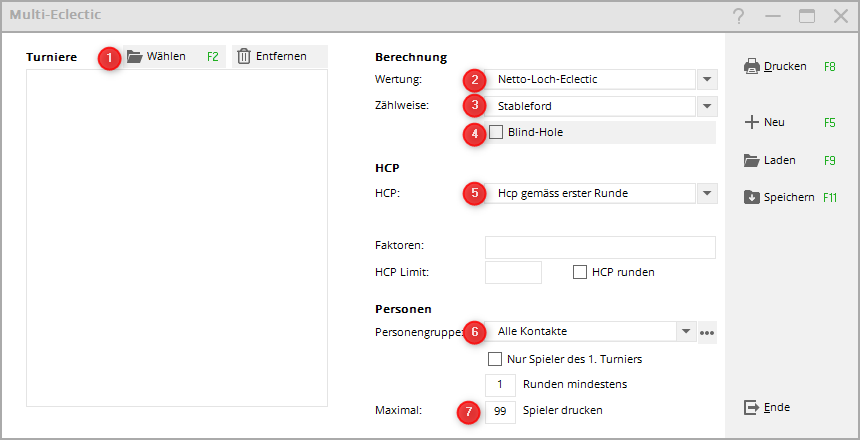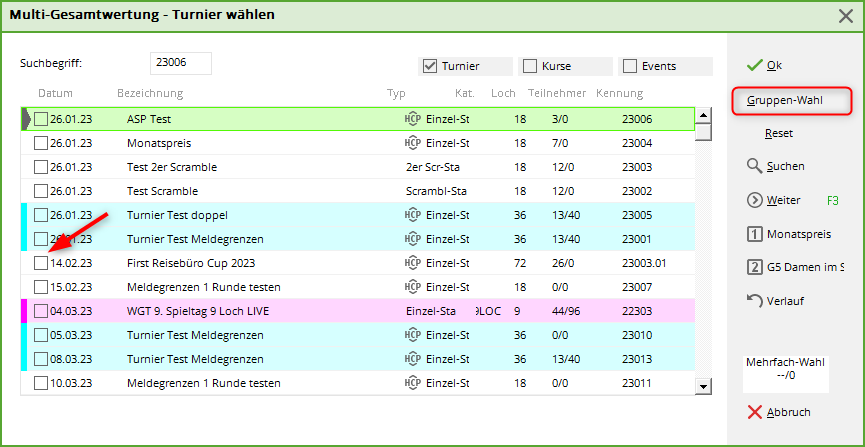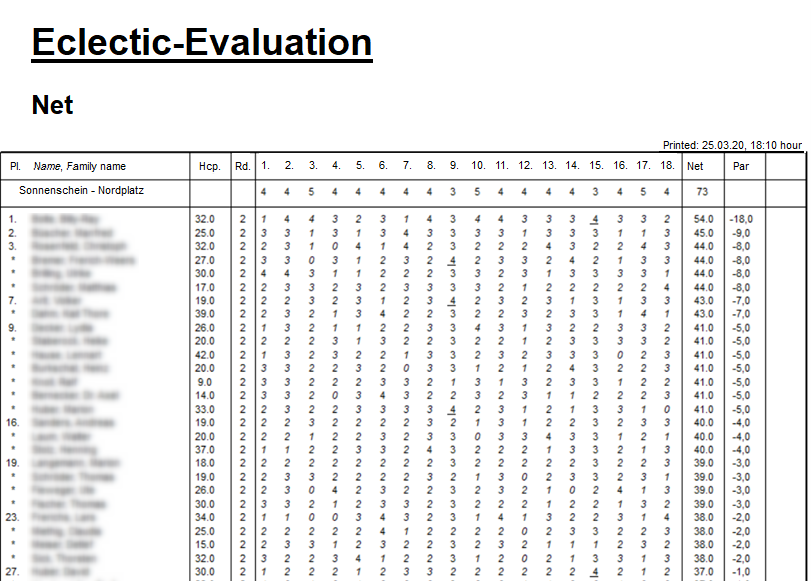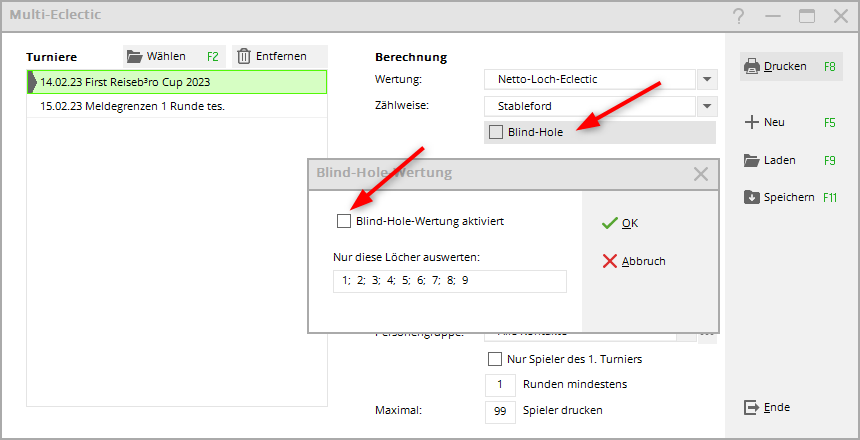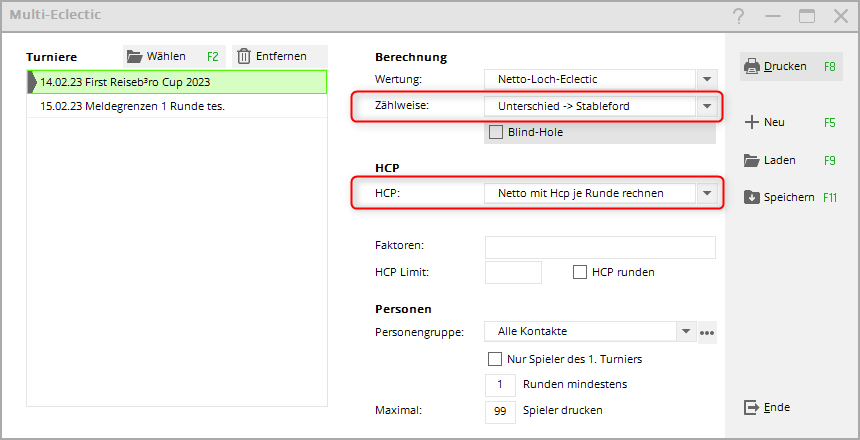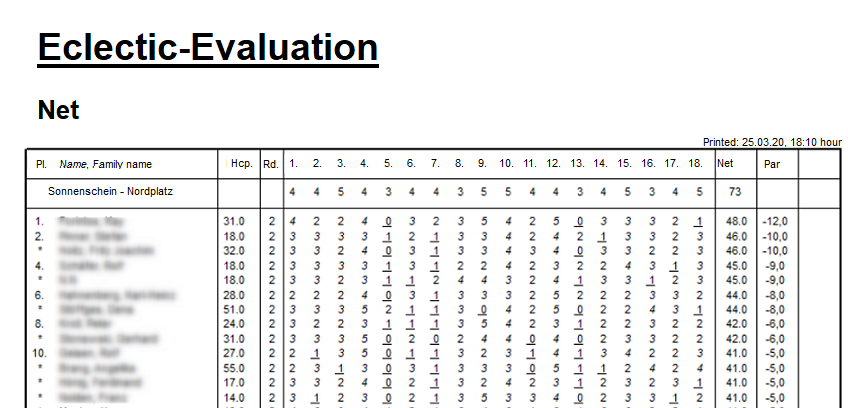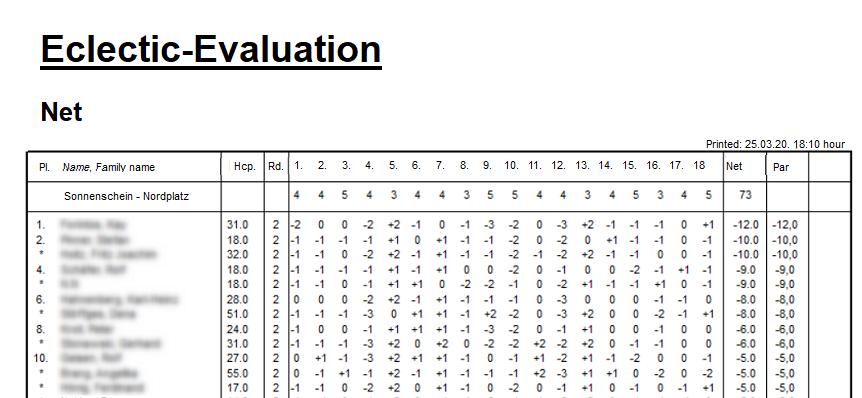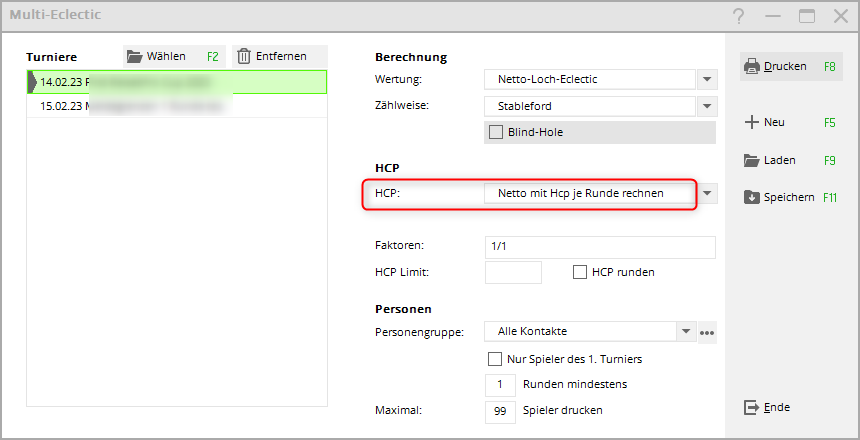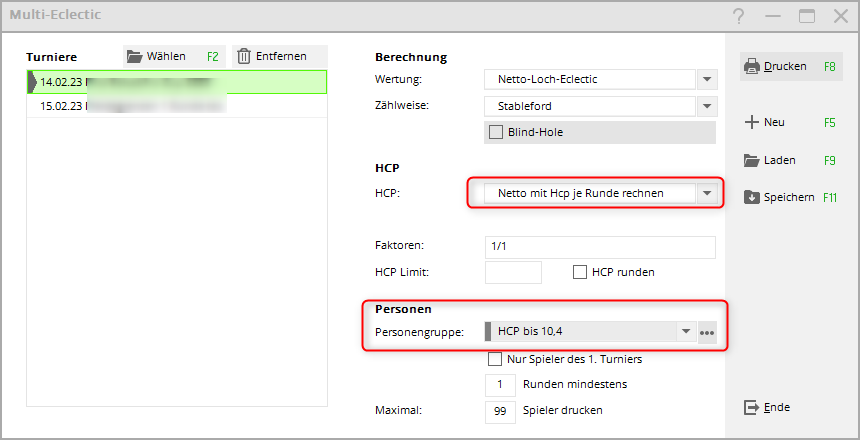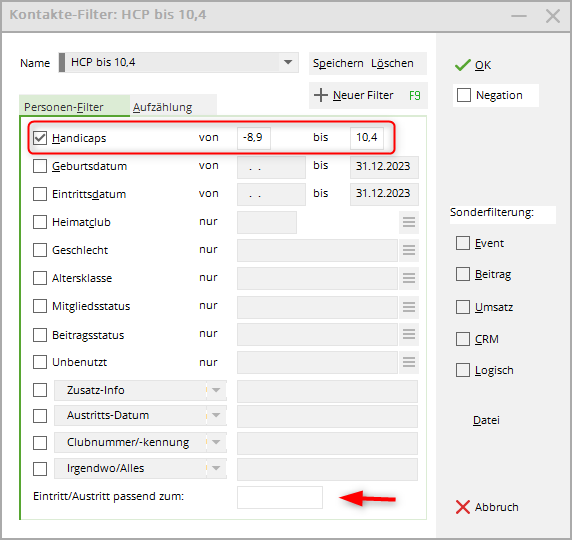Inhaltsverzeichnis
Annual Eclectic
Considerations in advance
A Multi-Eclectic can only for tournaments with game form SINGLE game form.
Normally the Eclectic is always evaluated over 18 holes, if you only play 9-hole tournaments tournaments, we recommend blind hole so that it is clear for the evaluation of PC CADDIE that no results are missing.
All tournaments selected for the Eclectic must have been played on the same course (all tees involved must have the same par values).
This is important as some courses have multiple courses. Please bear in mind that an evaluation
makes no sense if, for example, hole 16 is a par 3 on one course and a par 5 on another.
Also bear in mind that individual tees often have a different par for certain holes.
9-hole tournaments played on the course dates tee 10 to 18 can also be played on not also cannot be analysed at the same time (also because of the different par values), as these would be included in the analysis of holes 1 to 9, which would certainly not be desirable.
At the top of the Eclectic evaluation printout you can see for which course the evaluation is calculated with which par.
These considerations are all important. Do you want a comparison under the same conditions?
Or do you want different par values to be taken into account in the calculation?
Then read =>here
Basic settings
To create an eclectic ranking for several tournaments, select Tournaments/Multiple tournaments and Golfwochen/Drucken…/Jahres-Eclectic:
- Behind Scoring you have the choice between „Net Hole Eclectic“ or „Gross Hole Eclectic“.
- With the counting method you can choose between „Counting game“, „Stableford“, „Against par“ or „Counting game (only complete)“. If you select „Counting game (only complete)“, only players who have not cut a single hole will be shown on the list for previously selected Stableford tournaments. If you select „Counting game“, these players are shown with an asterisk because there is no result for 1 hole. Further options, which are interesting for different pars, can be found =>here
- Blind hole Use the Blind Hole option in an Eclectic to analyse the course data holes 1-9 (also for course 10-18)
- If you are using HCP „HCP according to last round“, the course handicap of the last round played from the tournaments in the Eclectic ranking is automatically used as the basis for the calculation. If you enter „HCP according to first round“, the course handicap of the first tournament played will be printed and used for the calculation. If you enter „Calculate net with handicap per round“, the handicap of the respective tournament day is used and also calculated with it. For the printout, it is the course handicap from the last tournament played. Of course, you can also enter a date for the key date of the HCP.
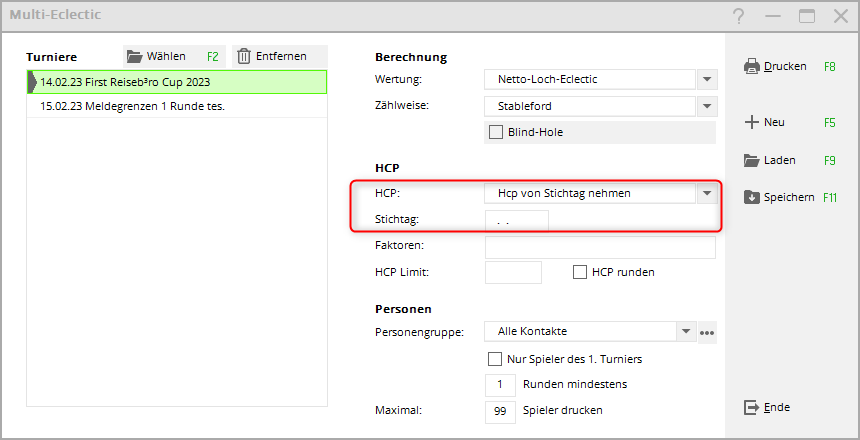
Your invitation gives you the factor for the handicap calculation. Otherwise leave this blank. - Under Person group everything can be set with regard to persons. Here you can set a person filter and specify, Only the players of the 1st tournament day. You can also note how many rounds had to be played.
- Under Maximum you can enter the number of players to be shown on the list.
Explanations for HCP: Key date and printed HCP on the list:
- If you enter „Calculate net with handicap per round“, each round is calculated with the Hcp and the rating that existed for the player on that day. Then the Hcp shown in the list is simply the course handicap that the player had at the last tournament played - but each round was of course calculated with an individual Hcp.
- You can also select „Handicap according to last round“, in which case the course handicap of the last round played is used, also for the printout.
- In the case of a cut-off date, the rating values are taken from the LAST round played, combined with the Hcp of the cut-off date, of course, which in turn may be different from the date of the last round.
Then go to Print (F8).
After clicking on the Print button button (F8), the following window appears:
Here you can enter an individual header text, which is also saved with the Eclectic definition.
If the tick for Hole results always as strokes even with Stableford is ticked, Stableford and counting game competitions can be evaluated in an eclectic.
Confirm the entries with OK:
Please note that in the HCP column, when using factors, the Course Handicaps according to the factor are shown.
The par differences are marked on the list accordingly in italics (underplay), underlined (overplay) or normal (par). An example expression looks like this:
The different display of individual results is a visual indication of special results, so you can easily see this in the counting game evaluation (for this example and this setting of the eclectic):
- Result underlined: played over par
- Result normal straight: played exactly par
- Result in italics: played under par
Saving and loading
If your club organises several annual Eclectic events, for example for men and women individually, we recommend that you save the settings under a specific name. You can start the saving process by clicking on the Save.
Please save in the PC CADDIE main folder TEXTE on the server, which PC CADDIE suggests, unless someone has set something else for you. With the TEXTE folder directly in PC CADDIE, the settings are still there even after a server move.
With Load you can easily reopen the rating. If you would like to create a new annual eclectic, this can be done with the button New button.
Print the previous results on the scorecard
You can print the hole results already achieved by the player on the scorecard. To do this, you must first display the Eclectic results list on the screen and then print out the scorecards. PC CADDIE can memorise the results and will print them on the scorecard as preliminary round results. For this to work, the scorecard must be configured with the corresponding field be configured.
Blind hole
If you want to evaluate individual holes, simply use the button blind hole button and enter the holes to be evaluated.
This function is also recommended for the evaluation of 9-hole competitions!
Playoff
Proposal for the jump-off in an Eclectic competition:
In the event of equal results, other criteria should be set for the play-off instead of further rounds other criteria, e.g. the result of the last 9, 6, 3, 1 holes of the Eclectic result minus the proportional handicap (net). The programming is also set up in this way because it is not possible to adopt play-off settings from individual tournaments.
Counting method "Difference" and "Difference Stableford"
A typical Eclectic evaluation normally only makes sense if the evaluation is made with the same course data, with the same PAR values (for all tees involved), as described above.
However, as many tee variants and course data variants have developed over the years, it is now possible to create an Eclectic evaluation with different par values (tees with different par values) for each player.
This evaluation only makes sense if you use only the values of the tournament days for the calculation without factors and without a cut-off date. The course displayed at the top of the lists is still the 1st course or tee found for the calculation (only 1 tee can be printed), even if the differences between the tees involved are calculated.
An evaluation with the actual number of strokes also makes no sense here due to different par values for the tees.
You have the option of using the „Stableford difference“ setting to print the difference to the par of the hole for the gross evaluation, or the gross Stableford points played.
For the net evaluation with „Stableford difference“, for example, you receive Stableford net points (which then also take into account different par values).
Example difference-Stableford
The course handicap of the first tournament played in the series is printed in the HCP column, but the calculation is always based on the respective course handicaps from the individual tournaments. With this setting, different par values are taken into account for the tees involved, and the best Stableford result per hole is then calculated.
Example "Difference"
For comparison: this is the same tournament as in the example: „Difference-Stableford“:
The different par values are also taken into account, but for the individual holes the difference is printed to the Stableford points that would have to be played for the HCP for the individual holes. This means that -1 means an underplay of 1 Stableford point; +1 is an overplay; 0 is a par played; etc.
Example Jab Anstoetz rating
Set the eclectic scoring as follows - example for classic eclectic - all par values in the sections are the same:
- Select the tournaments
- Set to „Net hole eclectic“
- Under HCP, select „Calculate net with HCP per round“ so that the current course handicap is used for the calculation.
- Under FACTOR enter: 1/1 (full handicap)
To determine the winner after a play-off (2012 competition) in the event of equal results, use the blind hole scoring by simply scoring the hardest hole the most difficult hole, then the two most difficult holes in the event of a further tie, etc…
Example //Betty Barclay// LADIES GOLF TOUR
Example of classic eclectics (all tees have the same par values).
The eclectic classification is an additional classification that is played over three tournament rounds within the advertised time limit. At the end of the third tournament day, the club's overall gross, net A, B and C winners are determined at the same time (the cut-off date for the classification is the last day of competition). The selection result of the Eclectic classification is calculated as follows: The highest number of Stableford points achieved per hole over several rounds is added together, whereby the lady's current course handicap on the day is taken as the basis for each day of play. Only the best result achieved from a maximum of three rounds played counts per hole. The overall net winner is therefore the player with the highest number of Stableford points in the respective class A, B or C. The overall winner of the gross classification is the player with the most gross points.
Set the eclectic scoring as follows:
- Select the tournaments
- Set to „Net hole eclectic“
- Under HCP, set „Calculate net with HCP per round“ so that the current course handicap is used for the calculation.
- Under FACTOR enter: 1/1 (full handicap)
- For the group of persons, enter the group of persons required for the respective net rating (A, B and C); you must print a separate list for each class. Please note that only the HCP of the last day of play can be used for the classification of the net classes. And is it is imperative that this list is created immediately on the last match day, as the HCPI values could be different the next day and the groups of people would therefore have different players in the filter..
To determine the winner after the play-off in the event of equal scores, use the blind hole scoring system by scoring only the hardest hole, then the two hardest holes in the event of further ties, etc…
- Keine Schlagworte vergeben

